In the competitive world of digital marketing, sending emails to invalid addresses is like burning money while damaging your reputation. Whether you’re managing consumer marketing campaigns or B2B outreach initiatives, email verification is the cornerstone of successful direct marketing that protects your deliverability rates while ensuring maximum accuracy.
This comprehensive guide reveals 11 advanced methods to verify email addresses without sending a single email, drawing from decades of professional list brokerage experience to help you build high-converting contact databases.
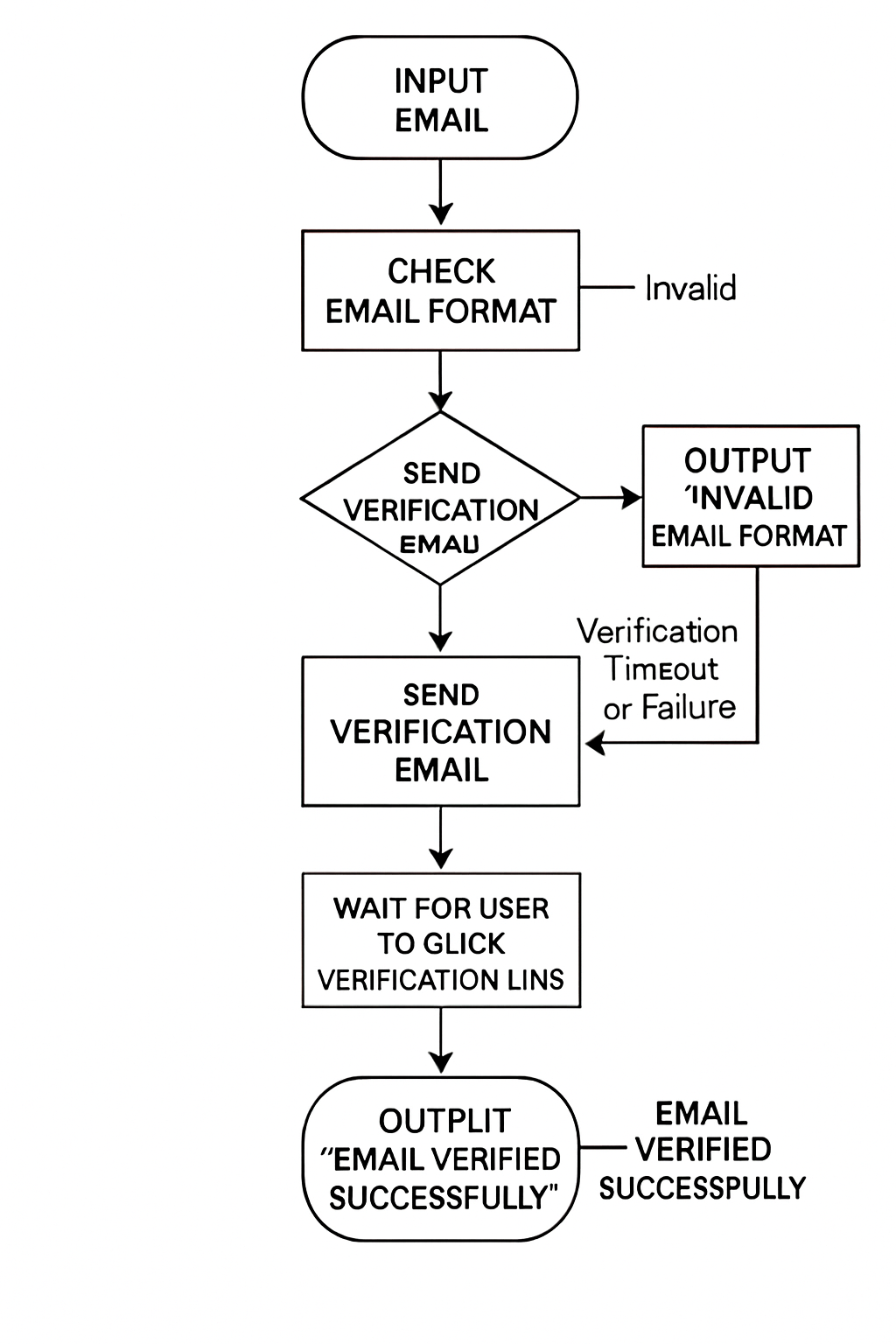
What is Email Verification?
Email verification is the process of confirming whether an email address is valid, active, and capable of receiving messages without actually sending an email to that address. This critical practice involves checking various technical components including syntax formatting, domain validity, mail server configuration, and recipient mailbox status.
Modern email verification combines automated tools with technical protocols to achieve accuracy rates exceeding 98%, making it essential for businesses that rely on email marketing, sales outreach, and customer communication. As any experienced direct marketing professional will tell you, clean data is the foundation of campaign success.
Why Verify Emails Without Sending?
Sending emails to unverified addresses poses significant risks including damaged sender reputation, reduced deliverability rates, and potential blacklisting. When you send emails to invalid addresses, internet service providers (ISPs) interpret this as poor list hygiene, which can result in:
- Bounce rates exceeding 5% triggering spam filters
- Sender reputation scores dropping below acceptable thresholds
- Email deliverability declining by 15-30% across all campaigns
- Domain blacklisting affecting all future communications
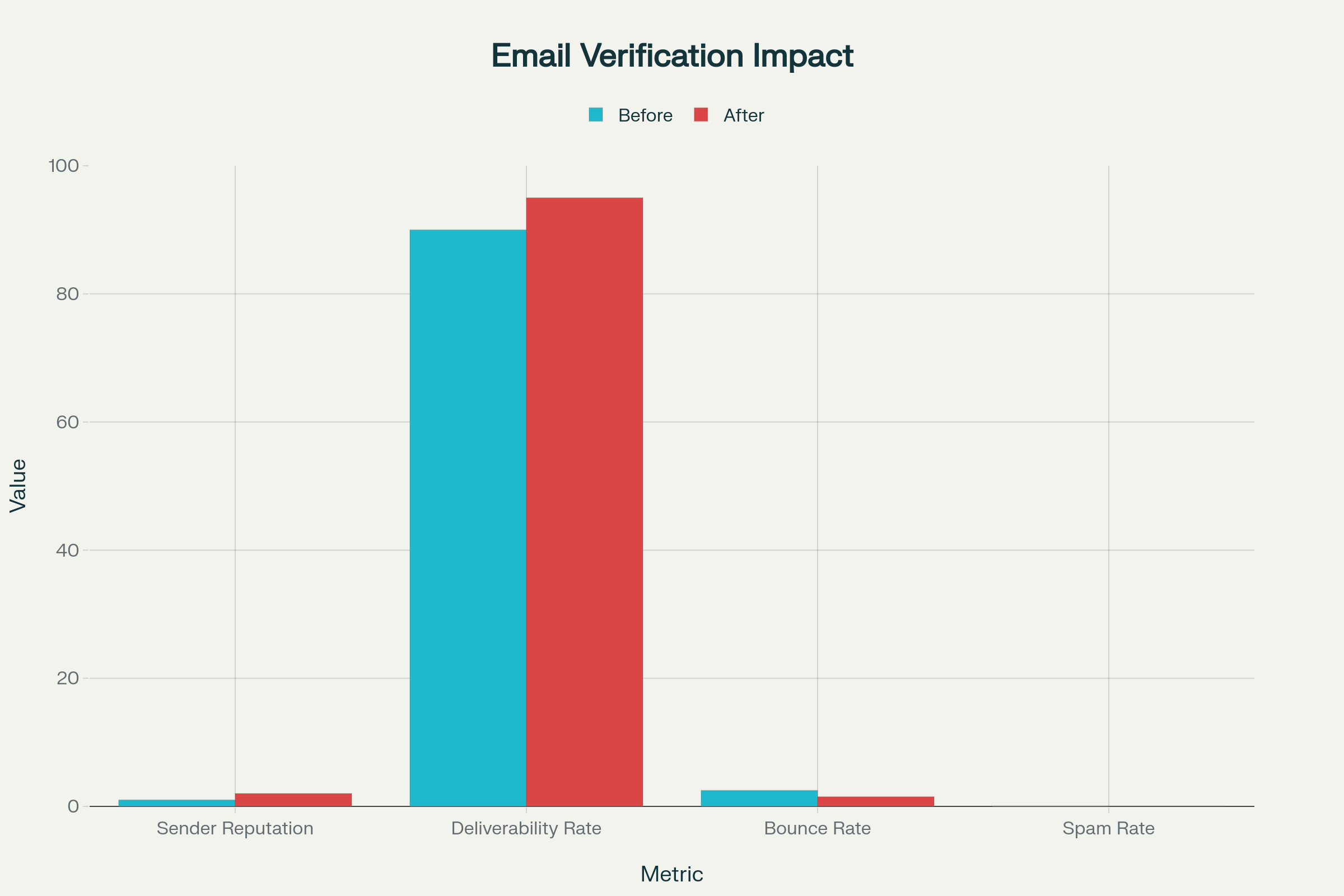
By verifying emails without sending, you maintain pristine sender reputation while building high-quality contact lists that drive better engagement and conversion rates. This approach is particularly crucial when working with specialized marketing databases where accuracy directly impacts ROI.
Understanding Email Infrastructure
Email Address Anatomy
Every email address consists of three essential components:
- Local part (before @): Contains letters, numbers, periods, hyphens, and underscores
- @ symbol: Separator between local part and domain
- Domain part (after @): Must be a valid, registered domain with mail exchange capabilities
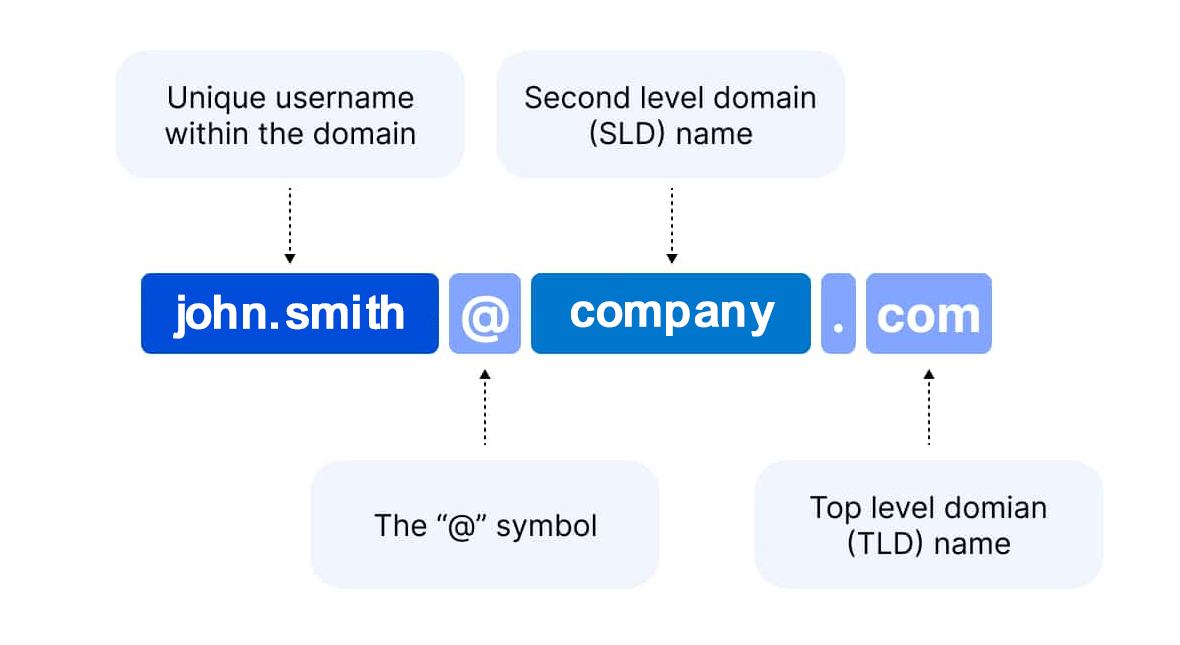
Understanding these components helps identify potential issues before they impact your campaigns. For comprehensive definitions of email marketing terminology, consult our business lists glossary which covers essential direct marketing concepts.
How Email Delivery Works
Email delivery follows a complex multi-step process:
- Sender’s mail server queries DNS for recipient domain’s MX records
- MX records direct the email to appropriate mail exchange servers
- SMTP handshake occurs between sending and receiving servers
- Recipient server validates the destination mailbox
- Email delivery completes or bounces based on validation results
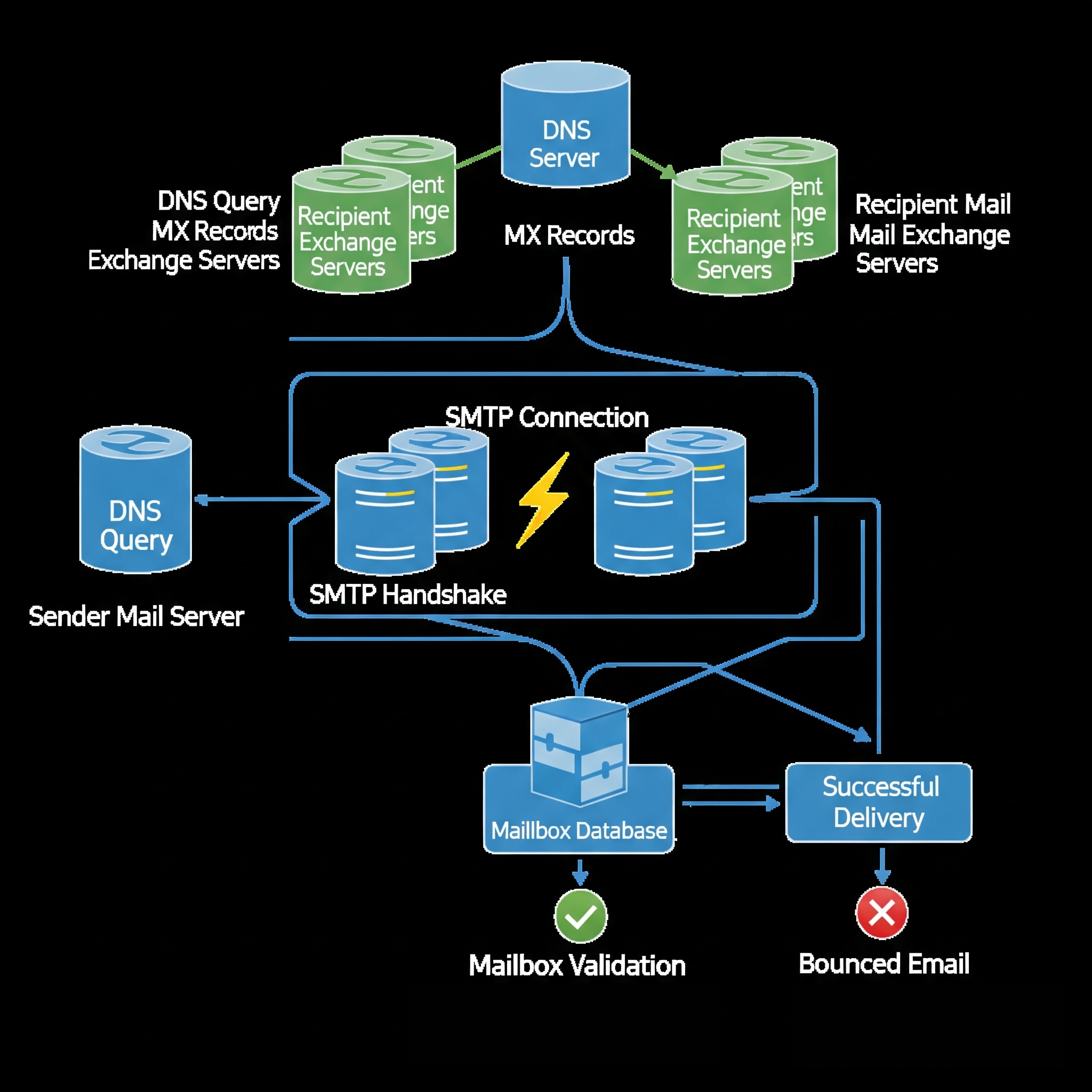
The 11 Methods to Verify Email Addresses Without Sending
1. Automated Email Verification Tools
Email verification tools use sophisticated algorithms to check multiple validation points simultaneously, providing accuracy rates between 95-99%. These tools automate the entire verification process by testing syntax, domain validity, MX records, and SMTP connectivity in seconds.
Professional list brokers often integrate these tools into their workflow to ensure high-quality prospect databases that deliver superior campaign performance.
Top Email Verification Tools Comparison:
| Tool | Accuracy Rate | Bulk Verification | API Available | Pricing |
|---|---|---|---|---|
| NeverBounce | 99.1% | Yes | Yes | $0.008/email |
| ZeroBounce | 98.7% | Yes | Yes | $0.007/email |
| Hunter.io | 97.3% | Yes | Yes | $0.01/email |
| Clearout | 98.5% | Yes | Yes | $0.009/email |
| EmailListVerify | 97.8% | Yes | Yes | $0.006/email |
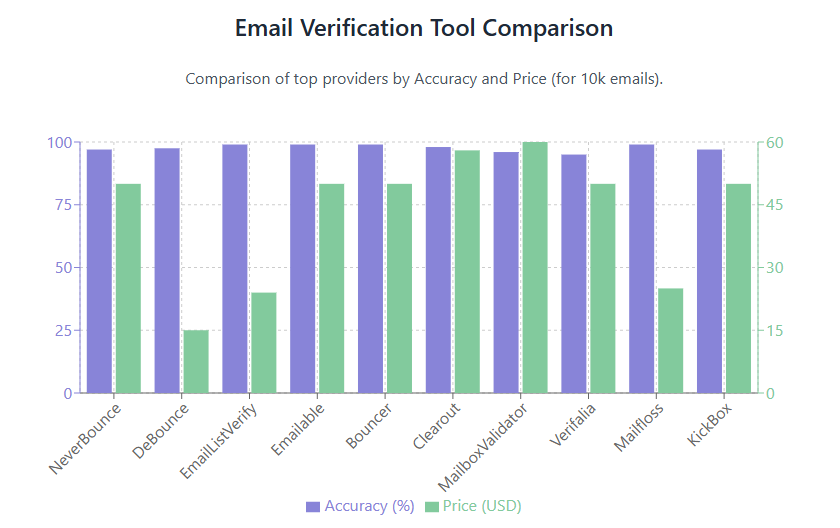
How Verification Tools Work:
- Syntax validation checks proper formatting
- Domain verification confirms domain existence
- MX record analysis validates mail server configuration
- SMTP testing connects to recipient server
- Mailbox validation confirms specific address existence
- Risk assessment identifies potential spam traps or disposable emails
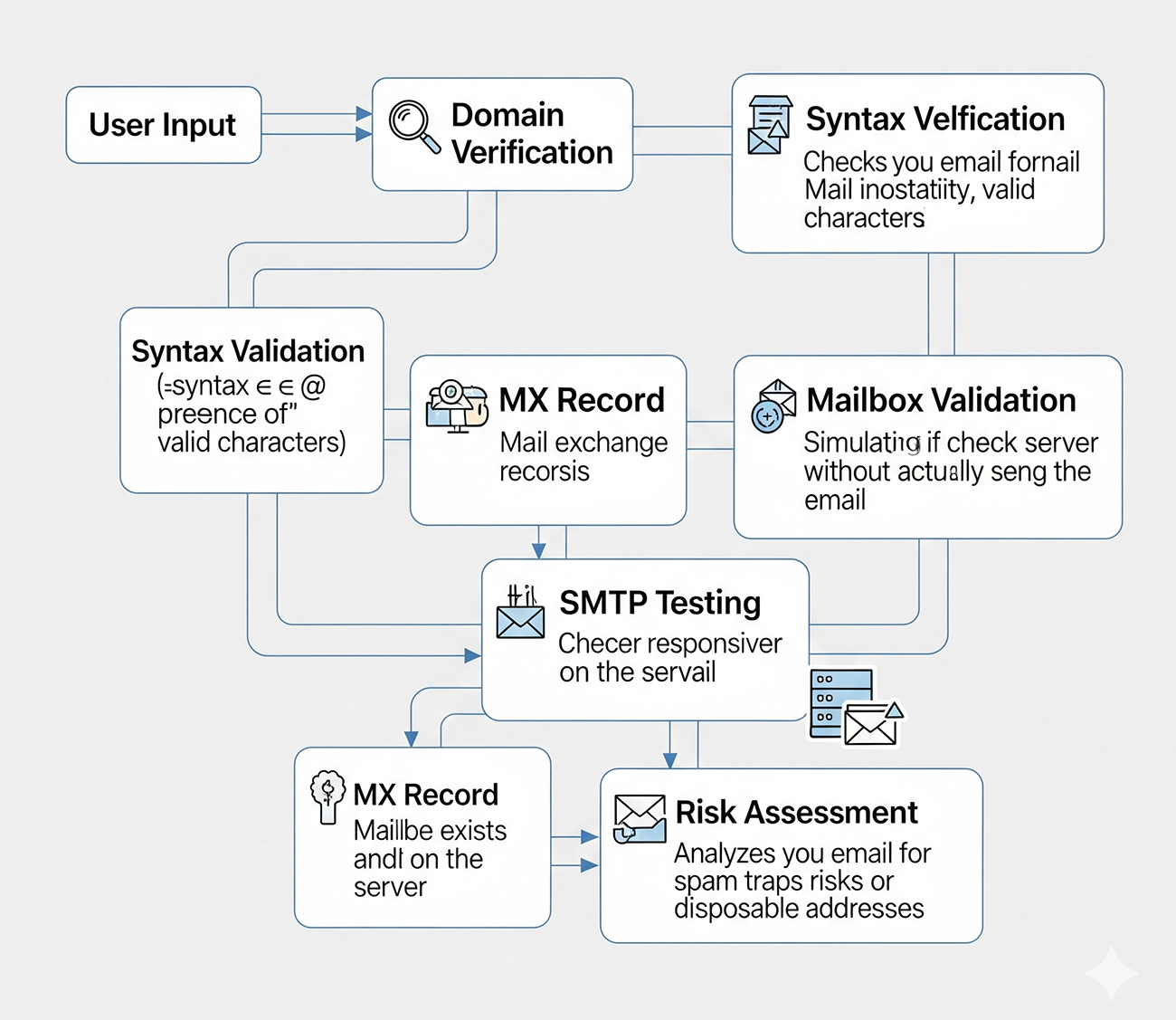
2. Syntax and Format Validation
Syntax validation ensures email addresses follow RFC 5322 standards, preventing immediate bounces due to formatting errors. This foundational check identifies obvious issues before proceeding with more advanced verification methods.
Common Syntax Errors:
- Missing or multiple @ symbols
- Invalid characters in local part
- Consecutive periods (..)
- Leading or trailing periods
- Spaces within the address
- Invalid domain extensions
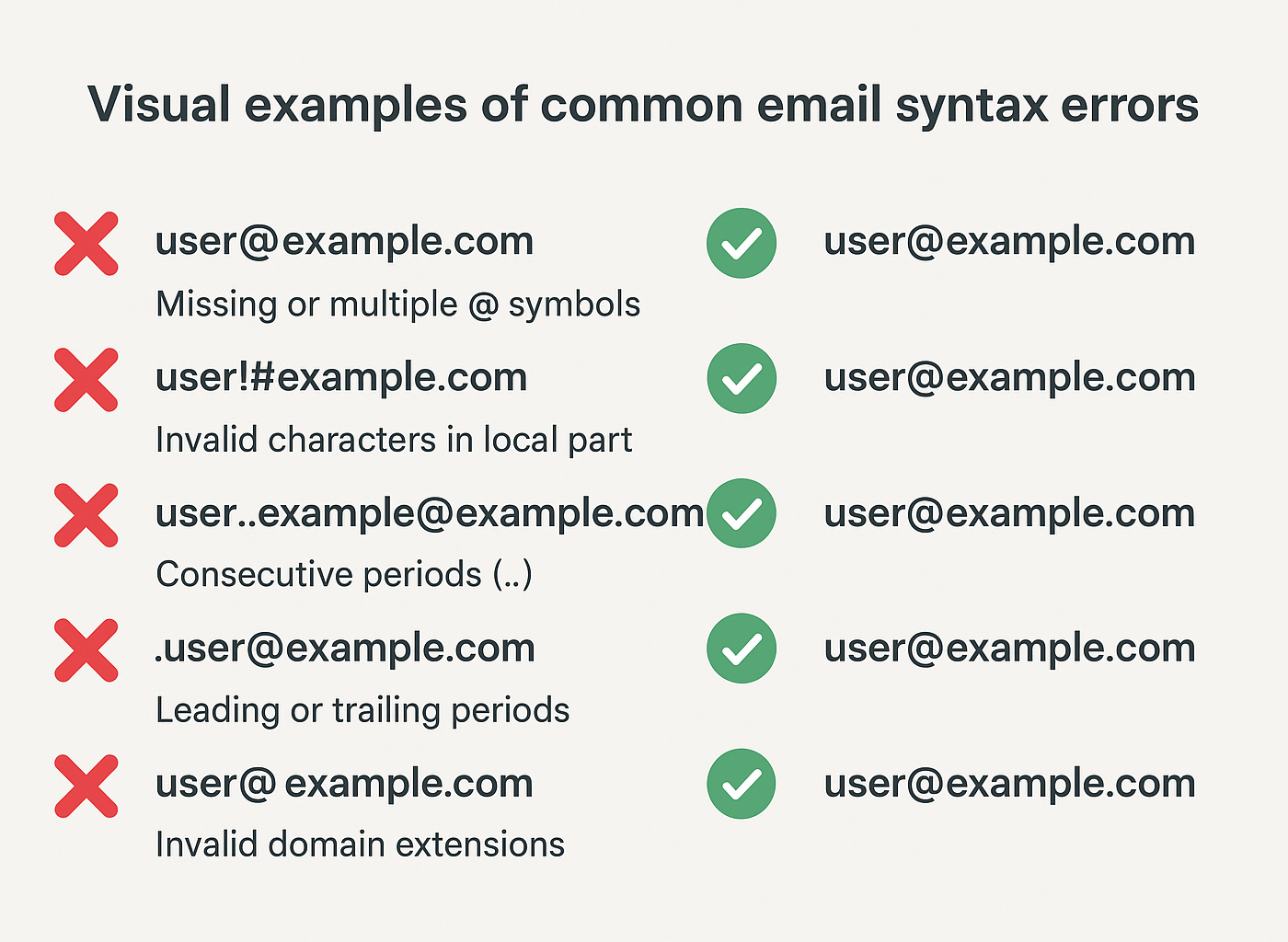
Understanding proper email formatting is crucial for maintaining clean marketing lists that comply with industry standards and maximize deliverability rates.
Manual Syntax Checking Process:
- Verify single @ symbol presence
- Check local part for valid characters (a-z, 0-9, ., -, _)
- Validate domain format (letters, numbers, hyphens, periods)
- Confirm TLD validity (.com, .org, .net, etc.)
- Test length limits (local part ≤64 characters, domain ≤253 characters)
3. Domain Existence Verification
Domain verification confirms that the domain portion of an email address represents a valid, registered domain capable of handling email traffic. This prevents emails from being sent to non-existent domains.
Domain Verification Process:
- Extract domain from email address
- Query DNS servers for domain records
- Check domain registration status
- Verify nameserver configuration
- Confirm domain resolution to IP address
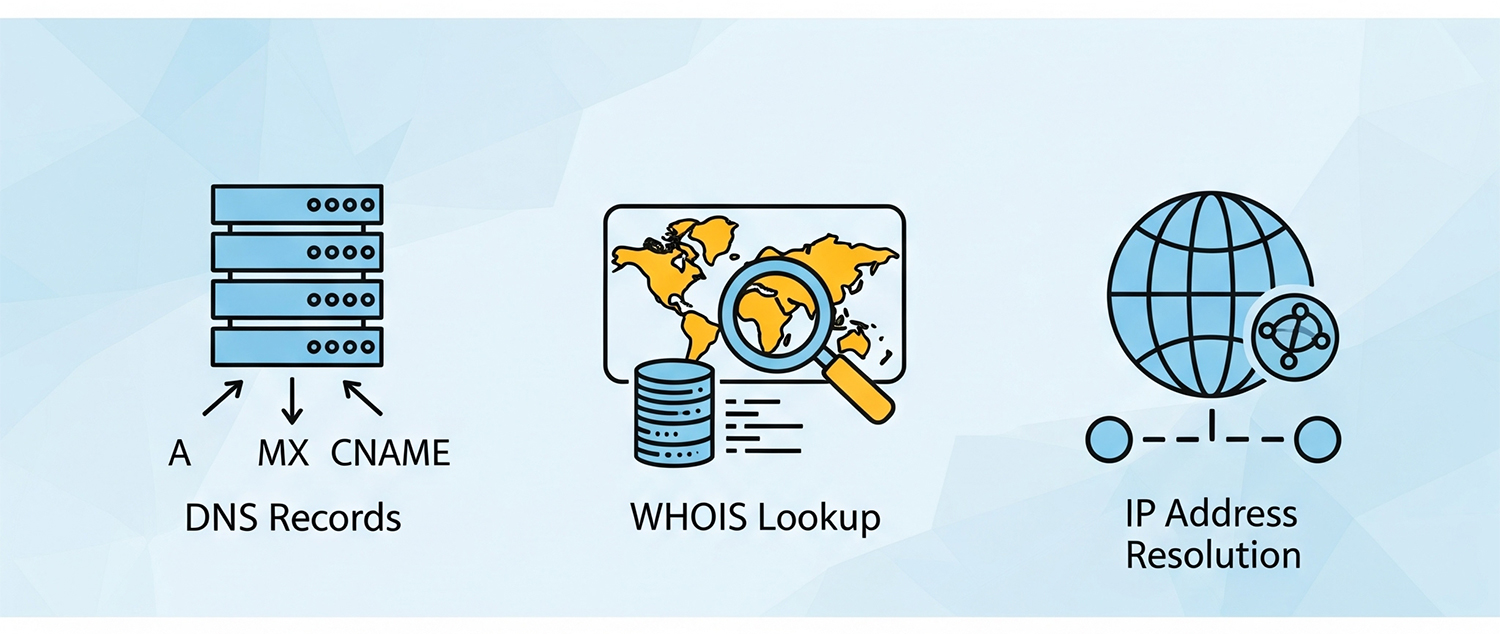
This verification step is particularly important when working with industrial contact databases where domain validity directly impacts B2B campaign success.
Tools for Domain Verification:
- Whois lookup services: Domain registration details
- DNS checker tools: Real-time domain status
- Ping utilities: Basic connectivity testing
- Domain age checkers: Registration history validation
4. MX Record Analysis
Mail Exchange (MX) records specify which mail servers handle incoming emails for a domain, making MX record verification essential for confirming email delivery capability. Valid MX records indicate that a domain is configured to receive emails.
MX Record Verification Steps:
- Query DNS for MX records using nslookup or dig commands
- Analyze priority levels (lower numbers = higher priority)
- Test mail server connectivity on port 25
- Verify server responsiveness to SMTP commands
- Check for backup MX records
Command Line MX Lookup:
nslookup -type=mx example.com
dig mx example.com
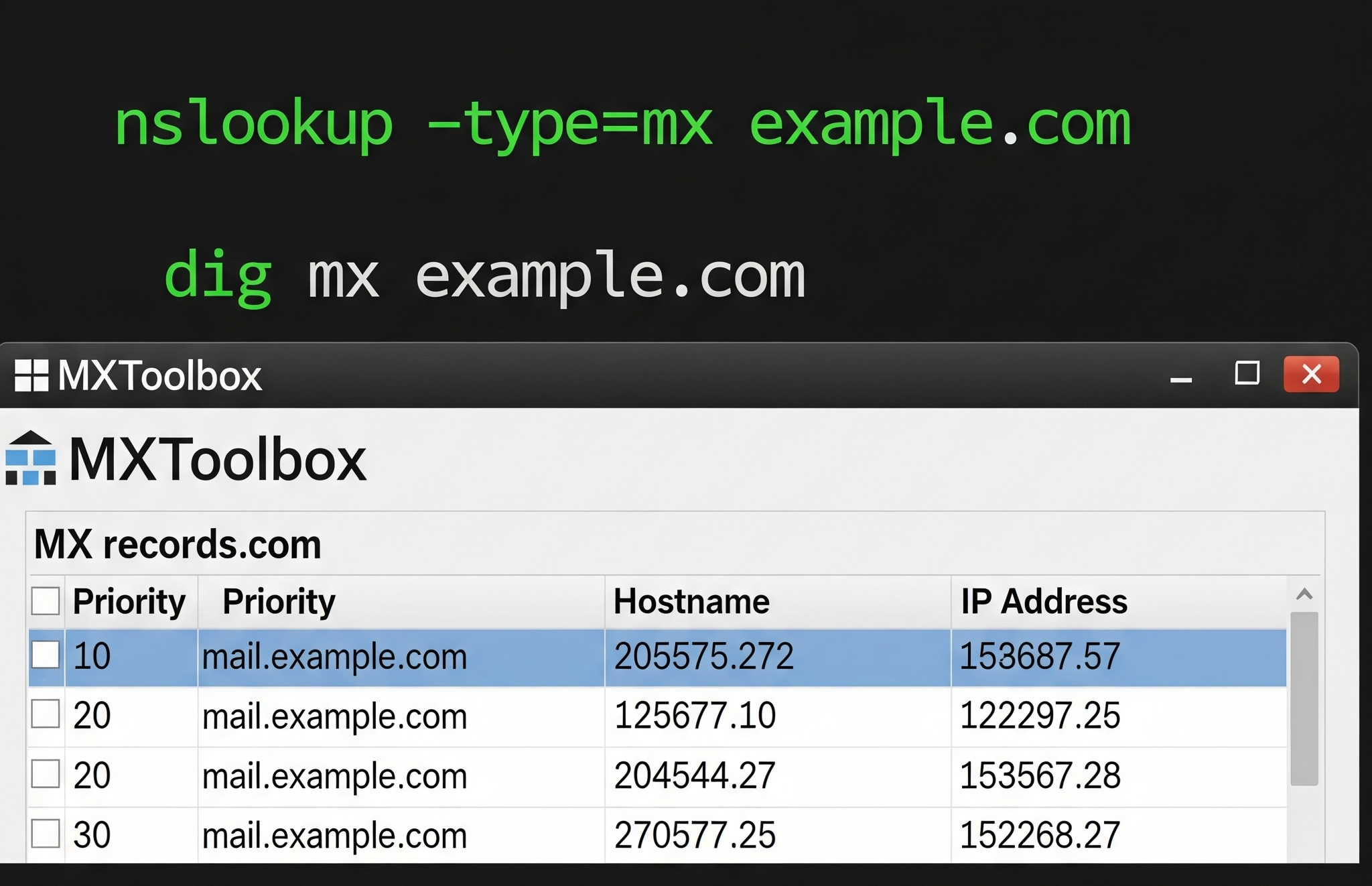
5. SMTP Connection Testing
SMTP (Simple Mail Transfer Protocol) testing involves establishing a connection with the recipient’s mail server and simulating the email sending process without actually delivering a message. This method provides the most accurate verification results.
SMTP Testing Process:
- Establish TCP connection to mail server on port 25
- Send HELO/EHLO command to introduce sending server
- Issue MAIL FROM command with sender address
- Send RCPT TO command with recipient address
- Analyze server response codes
- Close connection with QUIT command
SMTP Response Codes:
- 250: Command successful, address valid
- 550: Address does not exist
- 421: Service temporarily unavailable
- 452: Insufficient storage space
- 553: Invalid address format
6. DNS Lookup Procedures
Domain Name System (DNS) lookups provide comprehensive information about domain configuration, helping verify email infrastructure and identify potential issues. DNS analysis reveals multiple record types that impact email delivery.
Essential DNS Records for Email:
| Record Type | Purpose | Email Impact |
|---|---|---|
| A Record | Domain to IP mapping | Server location |
| MX Record | Mail exchange servers | Email routing |
| SPF Record | Sender authorization | Anti-spoofing |
| DKIM Record | Message authentication | Security validation |
| DMARC Record | Policy enforcement | Fraud prevention |
7. IP Address Investigation
IP address lookup reveals crucial information about email servers including geographic location, internet service provider, and reputation scores. This analysis helps identify potentially fraudulent or high-risk email addresses.
IP Investigation Process:
- Extract IP address from MX record resolution
- Query IP databases for ownership information
- Check blacklist status across major databases
- Analyze geographic location consistency
- Review reputation scores and history
This detailed investigation process is essential for maintaining the integrity of consumer marketing lists and ensuring compliance with anti-fraud measures.
8. Search Engine Investigation
Search engines provide valuable intelligence about email addresses by revealing associated online profiles, business listings, and social media accounts. This method helps confirm legitimacy and gather additional contact context.
Search Engine Verification Techniques:
- Google exact search: “email@example.com” in quotes
- Username analysis: Search local part separately
- Domain investigation: Company and organization verification
- Social media correlation: LinkedIn, Twitter, Facebook profiles
- Professional directory: Business listing confirmation
9. Social Media Cross-Referencing
Social media platforms serve as powerful verification sources, providing profile information that can confirm email address legitimacy and professional context. This method is particularly effective for B2B email verification.
Social Media Verification Process:
- LinkedIn profile search using name and company
- Twitter handle investigation for professional accounts
- Facebook business page verification
- Instagram professional account confirmation
- Company website contact page validation
10. Gmail Direct Verification
Gmail provides built-in email verification through its compose interface, offering a quick method to test email validity without sending messages. This approach leverages Gmail’s real-time validation system.
Gmail Verification Steps:
- Open Gmail compose window
- Enter email address in TO field
- Observe auto-suggestions and formatting
- Note error indicators for invalid addresses
- Check recipient suggestions for alternatives
11. Company Website Validation
Official company websites provide authoritative sources for email verification, particularly for business and professional email addresses. This method ensures emails belong to legitimate organizations and is especially valuable when building targeted prospect databases.
Website Verification Process:
- Visit company website directly
- Check contact page for official emails
- Review team/staff directory pages
- Verify domain consistency with email address
- Cross-reference multiple pages for confirmation
Advanced Verification Strategies
Role-Based Email Detection
Role-based emails (info@, support@, sales@) are managed by multiple people rather than individuals, requiring special handling in verification processes. These addresses often have different engagement patterns and deliverability characteristics.
Common Role-Based Patterns:
- Administrative: admin@, info@, contact@
- Sales: sales@, business@, enquiries@
- Support: support@, help@, service@
- Technical: tech@, webmaster@, it@
Understanding role-based email patterns is crucial for direct marketing success and helps optimize targeting strategies based on recipient type.
Disposable Email Identification
Disposable email services create temporary addresses that expire after short periods, making them unsuitable for long-term communication. Identifying these addresses prevents wasted marketing efforts and protects campaign performance.
Popular Disposable Email Domains:
- 10minutemail.com
- guerrillamail.com
- mailinator.com
- tempmail.org
- throwaway.email
Spam Trap Recognition
Spam traps are email addresses created specifically to catch spammers and poor list hygiene practices. Sending emails to spam traps can result in immediate blacklisting and reputation damage.
Business Impact Analysis
Deliverability Rate Improvement
Proper email verification can improve deliverability rates by 25-40%, directly impacting campaign performance and revenue generation. Clean email lists result in:
- Reduced bounce rates below 2%
- Improved inbox placement rates above 90%
- Higher engagement metrics across campaigns
- Better sender reputation scores with ISPs
ROI Optimization
Email verification provides measurable ROI through reduced costs and improved performance:
| Metric | Before Verification | After Verification | Improvement |
|---|---|---|---|
| Bounce Rate | 12% | 1.5% | 87.5% reduction |
| Deliverability | 73% | 94% | 28.8% increase |
| Open Rate | 18% | 24% | 33.3% increase |
| Cost per Lead | $15 | $9 | 40% reduction |
These improvements are particularly significant when working with high-value prospect lists where every contact represents substantial revenue potential.
Legal Compliance
Email verification supports compliance with international privacy laws including GDPR, CAN-SPAM, and CCPA by ensuring communication only occurs with valid, consenting recipients. For organizations focused on fundraising and donor communications, understanding these requirements is essential, as detailed in our comprehensive direct marketing compliance guide.
Implementation Guide
Setting Up Verification Workflows
Effective email verification requires systematic workflows that integrate verification at multiple touchpoints:
- Real-time verification during form submissions
- Bulk list cleaning before campaign launches
- Regular maintenance of existing databases
- Integration monitoring for ongoing accuracy
- Performance tracking and optimization
CRM System Integration
Seamless CRM integration ensures verified emails flow directly into sales and marketing systems:
Popular CRM Integrations:
- Salesforce: Native API connections
- HubSpot: Built-in verification features
- Pipedrive: Third-party integrations
- Marketo: Automated workflow triggers
- Pardot: Real-time validation rules
Professional list management services can help configure these integrations to maximize efficiency and accuracy across your marketing technology stack.
Troubleshooting and Common Issues
False Positive Management
False positives occur when valid emails are incorrectly flagged as invalid, requiring careful analysis and correction:
Resolution Strategies:
- Implement retry logic with exponential backoff
- Use multiple verification methods for cross-validation
- Monitor accuracy metrics and adjust thresholds
- Maintain whitelist of known valid domains
- Regular manual review of flagged addresses
High Bounce Rate Solutions
Persistent high bounce rates indicate systematic issues requiring comprehensive solutions:
Diagnostic Steps:
- Analyze bounce categories (hard vs. soft bounces)
- Review list sources and acquisition methods
- Check verification tool accuracy and settings
- Examine sending practices and frequency
- Investigate reputation scores and blacklist status
Future of Email Verification
AI-Powered Verification
Artificial intelligence is revolutionizing email verification through machine learning algorithms that improve accuracy and predict email validity patterns. These advances are particularly valuable for organizations implementing advanced marketing automation strategies that require precise audience targeting.
Emerging Technologies
New technologies are expanding email verification capabilities:
- Blockchain verification for identity confirmation
- Real-time API improvements for instant validation
- Mobile-first verification for SMS integration
- Social graph analysis for relationship mapping
- Advanced fingerprinting for device tracking
Conclusion and Action Steps
Email verification without sending emails is not just a best practice—it’s a business necessity in today’s digital landscape. The 11 methods outlined in this guide provide comprehensive coverage for any verification scenario, from individual address checking to bulk list cleaning.
Immediate Action Steps:
- Audit your current email lists using multiple verification methods
- Implement automated verification for all new email acquisitions
- Choose appropriate tools based on your volume and budget requirements
- Integrate verification workflows with existing systems
- Monitor and optimize performance metrics continuously
Start with syntax validation and domain verification for immediate improvements, then gradually implement advanced methods like SMTP testing and social media cross-referencing for comprehensive coverage. Whether you’re managing consumer databases or specialized B2B lists, regular verification maintenance will protect your sender reputation while maximizing email marketing ROI.
The investment in proper email verification pays dividends through improved deliverability, higher engagement rates, and reduced compliance risks. For businesses seeking professional assistance with email list management and verification, consider partnering with experienced direct marketing professionals who can provide expert guidance and proven solutions.
Begin implementing these strategies today to transform your email marketing effectiveness and build sustainable, high-quality contact databases that drive business growth and maximize your marketing investment.




